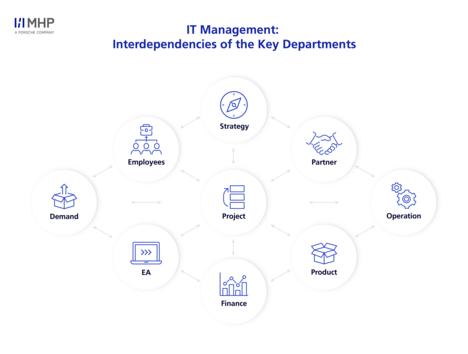
- Blog, Cloud
- Published on: 06.03.2024
- 9:15 mins
IT Management: Technology Business Management for Greater Transparency
Over the past two decades, information technology has developed at a rapid rate: In 2005, companies across the globe invested $2.6 trillion in their IT departments; by 2022, this figure had already reached $4.4 trillion. According to forecasts, global IT spending is expected to reach $5 trillion in 2024, with an estimated $1.1 trillion to be spent by European-based companies alone.
As investments in IT increase, so does the importance of high-performance IT management. After all, larger budgets require more accurate management to keep track of costs. This is where technology business management (TBM) comes in: It not only allows you to record your IT expenses in a transparent way – you can also manage them efficiently and with an eye on value. In short, TBM transforms your IT management into a strategic tool that allows you to maximize the value of every investment.
Challenges in Implementing Holistic IT Management
Many companies face challenges when it comes to IT governance. These are largely due to a lack of cost transparency and unclear application landscapes. There is often a disconnect between a business’ requirements and its IT strategy. This makes it difficult to get a clear overview of the workload of IT employees and, with it, the availability of resources. The lack of cross-departmental collaboration is another obstacle and one which leads to a further lack of transparency. A strategic realignment is needed to overcome these barriers and to enable holistic, effective IT management.
Implementing holistic IT governance necessitates far-reaching changes. IT departments can no longer just think in terms of technology; they also need to think in terms of the business as a whole. This change requires a three-pronged attack: processes need to be adapted, targeted training needs to be implemented, and the corporate culture needs to undergo a transformation.
A transformation like this often poses a challenge for organizations, but they do not have to overcome it alone. Working with an experienced partner is highly recommended here. They will not only use TBM to support you in the transparent presentation of IT costs but can also provide support throughout the associated transformation process.
Holistic IT Management with Technology Business Management (TBM)
Transparency and consistency are vital when it comes to facilitating expedient IT governance. The most sustainable way to do this is with TBM.
Building on a foundation of transparency
The importance of IT governance to a company is directly correlational to the percentage of the overall company budget that IT costs make up. It is critical to continually monitor and review all tasks, processes, resources, and solutions to identify potential vulnerabilities and implement optimizations that can reduce the overall cost of IT.
However, there are multiple challenges associated with the traditional methods of IT management. The problem begins with the use of numerous tools, which are often only partially compatible. In order to compare data, employees are forced to switch between different tools. This not only leads to errors but also to a discrepancy in data quality. Even experts have difficulty making informed decisions due to this fragmented approach.
The role of technology business management in IT governance
Technology business management encompasses all methods and measures that enable a holistic view of the costs and benefits of IT. TBM enables:
- transparency, planning, billing, benchmarking, and optimization of investments in technology,
- impactful financial management, cloud transformation, and digital innovation results,
- the meaningful comparison of investments in technology with their actual business value,
- appropriate and standardized cost allocation according to usage.
Overall, it is a discipline that improves business continuity and results, as it provides companies with a consistent way to convert investments in technology into business value.
Manage IT Like a Business: The Benefits of TBM
Effective IT management is a key factor when it comes to the success of a company, and it requires a holistic approach. TBM has lots of opportunities and benefits to offer your company, including:
- Increased transparency in IT spending: TBM gives you a detailed overview and control over IT costs, resulting in more efficient budget management.
- Strategic decision-making: By improving enterprise architecture and portfolio management, TBM supports informed, strategic decisions.
- Positioning IT as a strategic partner: TBM helps the IT department grow beyond its role as a cost center so it can be recognized as an integral part of the company’s business strategy.
- Reducing knowledge barriers: TBM leads to improved communication and collaboration between IT departments and other business areas, in turn promoting the reduction of knowledge silos.
- Aligning IT with business goals: TBM ensures that IT activities and investments align with business goals, increasing overall effectiveness.
- Optimized implementation of IT strategies: By providing a clear overview of resources and capacities, TBM makes it easier to implement and adapt IT strategies.
- Improving trust in IT: TBM presents IT spending in a transparent way. This key feature increases trust among stakeholders and managers regarding the efficiency and effectiveness of the IT department.
Optimize Your IT Management with TBM
When it comes to successfully utilizing TBM to improve IT management, an integrated approach is required. This approach needs to cover different key areas, such as IT financial management (ITFM), enterprise architecture, strategic portfolio management, enterprise agility, and change management.
This requires effective and transparent communication between these areas in order to obtain the necessary information for IT management. Strategic portfolio management prioritizes projects according to the corporate strategy, while enterprise agile planning (EAP) ensures flexible implementation, and ITFM monitors budget compliance.
This collaboration ensures that financial resources are used efficiently for IT initiatives that are consistent with strategic planning.
Architecture and project management
Enterprise architecture management (EAM) focuses on the optimal integration of business processes and IT systems in order to increase the efficiency and agility of a company. The capability map represents the entire organization, including all its processes, information, and resources. The capability map is created in compliance with strict rules for data management including collection, analysis, and protection of data, which are guaranteed by data governance to avoid data breaches.
A thorough analysis of the current situation and target scenario are crucial for the planned implementation of TBM: Where does the company currently stand and what goals are to be achieved? The choice between a completely new start (greenfield approach) and building on existing processes and structures (brownfield approach) requires careful evaluation. To do this, it is important to define specific use cases and to carefully examine which approach ensures the more effective implementation of TBM within the context of your company.
Bee360: A solution for holistic IT management
Bee360 offers CIOs a holistic solution for strengthening collaboration between IT departments and other areas of the business. The strategic tool ensures that the IT department is aligned with company goals and strategies. Bee360 focuses on all areas of the company – from enterprise architecture to financial controlling to research and development – and thus enables precise requirements management for IT.
By identifying current and target states as well as a tailor-made adaptation of the tool to day-to-day operations, Bee360 supports companies in addressing their individual needs. The importance of interface analysis and expansion within this platform is of particular note, as it ensures seamless integration and interaction between the different areas.
Bee360 training and learning resources
In addition to the platform, companies that implement Bee360 also receive specific training on how to use the tool, as well as more general training that addresses the methodologies of each business area. Comprehensive documentation, consisting of manuals and business process model and notation (BPMN), ensures detailed step-by-step guidance. You can also define roles and permissions via Bee360 in order to specifically control the configuration of the various company areas.
The go-live & roll-out
Depending on the size of the company, the tool can either be implemented gradually or for all employees at the same time. Companies often initially decide on test phases during which the tool is introduced in a specific branch or department. This allows for the initial workflows to be carried out on a smaller scale and gives companies the chance to make iterative adjustments before a comprehensive roll-out.
Continuous improvement
Once a new system has been implemented, the hypercare phase occurs, which is intended to ensure that all functions operate according to expectations. During this phase, employees have a contact partner who is on hand to resolve any issues while system functionality is closely monitored. Automating the interfaces between the individual areas enables smooth access to information and ensures improved data and transparency. Additional performance optimization approaches can also be identified during this phase. These approaches can be used to streamline business operation processes and thus increase cost efficiency
Applying the Bee360 principles
A comprehensive management approach in line with Bee360 principles is pursued throughout the entire project. The approach is based on holistic action, targeted leadership of those involved, and rapid, dynamic execution. Bee360 places particular emphasis on transparent processes and promotes decentralized decision-making. A data-oriented approach forms the basis for using relevant information effectively so well-founded decisions can be made at all levels.
Collaborate with MHP and Reap the Rewards
MHP’s certified and experienced experts support customers in the transformation of their IT management. The coaching provided enables companies to establish their own CIO office. As a Bee360 partner, MHP utilizes all the advantages of the platform in the best interests of clients. Our expertise extends to digital services, data analysis, data security, software development, as well as system management and integration. Areas of activity include digital transformation and comprehensive CIO consulting. There are a variety of tools available to accurately reflect the value of your IT landscape. Make the most of our expertise and let us advise you!
IT Trends: The Future of TBM and IT Governance
More and more companies are focusing on TBM in order to meet the growing requirements in complex corporate processes. The increased use of Artificial Intelligence (AI) and automation to collect and analyze data is a key trend in the field of TBM. This evolution enables IT managers to precisely control the impact of technology investments, make data-driven decisions, and identify opportunities for cost savings. In addition, TBM is often integrated into information technology management frameworks like the Information Technology Infrastructure Library so a comprehensive IT management strategy can be developed to ensure the highest level of IT governance.
TBM – A Pioneer for Efficiency and Transparency that is Changing IT Management for Good
IT development is advancing rapidly and effective IT management is becoming increasingly important as a result. TBM makes it possible to manage IT investments with transparency and a focus on value. TBM offers great potential for optimization, particularly when targeted at the challenges posed by a lack of cost transparency and complex IT structures. Within this context, the combination of Bee360 and MHP’s support represents a groundbreaking solution that promotes collaboration between IT departments and other business areas to facilitate holistic governance. MHP is your partner on the path to digital transformation. Get in touch and make the most of this opportunity to actively shape the future of your IT management.
FAQs – IT Management
TBM allows you to identify cost drivers, optimize processes, and step in early when projects are at risk of overshooting their goals. It also improves communication and collaboration between different areas of the company.
TBM creates interfaces between company departments, which in turn serve to facilitate and promote the exchange of information. The result: opportunities for simplification, streamlining, and improvement can be more easily identified.
Some employees may show a reluctance to adopt a new system. This problem can, however, be easily resolved through appropriate training that takes individual knowledge and skills into account and through thorough support during the hypercare phase.
Experienced experts adapt the system using an iterative model. They can also provide in-depth explanations of the measures required as well as offer specific training for employees.






